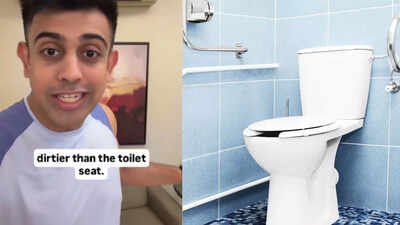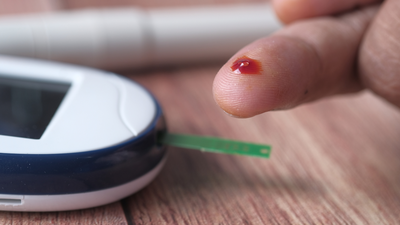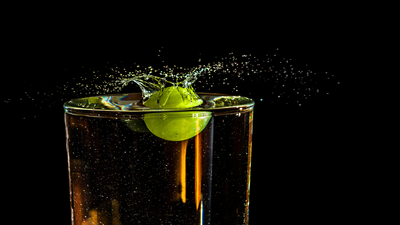5 household items far dirtier than your toilet seat: How germs spread and simple hygiene tips from a surgeon |

Most people believe the toilet seat is the dirtiest spot at home, but that’s far from true. Orthopaedic surgeon Dr. Manan Vora highlights that everyday objects we touch frequently harbor far more germs. Items like TV remotes, smartphones, cutting boards, pillow covers, and kitchen sponges can trap food particles, sweat, oils, and moisture, creating ideal conditions for bacteria, fungi, and viruses. Because these objects are rarely disinfected, they become hidden germ hotspots that spread illness more easily than a toilet seat. Regular cleaning, drying, and timely replacement are essential to minimise contamination. By focusing on these overlooked items, adopting smart cleaning habits, and practicing better hygiene, you can reduce infection risks and create a truly healthier living environment.
How everyday items turn into germ reservoirs: Orthopaedic surgeon reveals
Objects become germ reservoirs for three simple reasons: frequent hand contact, contact with bodily fluids or food, and environments that let microbes survive (moisture, organic material, and nooks or scratches). If an item is handled by many people, touched right after food or bathroom use, or stays damp, it will accumulate bacteria, viruses and fungi much faster than a surface that’s wiped regularly. Another factor is perception: people often assume things “look clean” and so don’t disinfect them, which lets microbes silently multiply.
5 everyday household items that are dirtier than your toilet seat
The TV remote is handled repeatedly throughout the day by different hands, often after snacking, before/after using the bathroom, and without any interim handwashing. Greasy fingerprints, food residue and skin cells create a thin film that traps microbes and protects them from drying out. Because remotes are made of textured plastics and have seams around buttons, microbes can lodge in tiny crevices where a quick dusting won’t reach. Over time that means bacteria and viruses are not only present on the surface but tucked into places that survive ordinary wiping.To manage remotes, make cleaning a habit. Remove batteries when possible and wipe every surface with a screen-safe disinfectant or 70% isopropyl alcohol wipe, taking care not to soak the electronics. Focus on the front and the underside and let it dry fully before reinserting batteries. If you have a remote cover, choose washable silicone or cloth covers and launder them regularly. During cold or flu season or if someone in the house is ill, clean remotes daily.Cutting boards are used with raw meat, vegetables, bread and more — and the knife grooves that form over time trap microscopic food particles and juices. Those trapped residues provide nutrients and moisture that let bacteria such as Salmonella or E. coli persist and multiply. The real danger is cross-contamination: the same board used for raw chicken and then for chopped salad without proper cleaning creates a direct path for pathogens from raw food to your ready-to-eat meal.Reduce risk by committing to a no-compromise routine. Use separate boards for raw proteins and for fruits/vegetables, or designate color-coded boards so everyone in the household knows which is which. For plastic boards, a thorough wash in hot, soapy water followed by running through the dishwasher will sanitise effectively. For wooden boards, wash with hot soapy water, dry immediately and store upright for airflow; if deep grooves develop, sand or replace the board. Sanitise periodically according to the board’s care instructions, and never rely on a quick rinse, clean immediately after each use and dry completely.Smartphones go places our hands go: public transport, bathrooms, gym equipment, restaurants and shopping carts. We press phones to our faces, then touch food or kitchen surfaces, so microbes transfer back and forth constantly. Cases, screen edges and ports trap oils and particles, and because phones are rarely disinfected, they become moving reservoirs that bring microbes into otherwise clean spaces.Treat your phone like a personal hygiene item. Wipe screens and cases with manufacturer-approved disinfectant wipes or a 70% isopropyl alcohol wipe; avoid spraying liquids directly. Clean phone cases separately and wash hands before and after heavy public use. If you use your phone while eating, adopt the habit of washing hands immediately before touching food or handle eating utensils instead of propping food with your hand and phone.Each night your pillowcase soaks up sweat, skin oils, flakes of dead skin and saliva — all of which are food for microbes and dust mites. Over weeks, this build-up can lead to bacterial and fungal growth and aggravate skin issues or allergies. Because pillowcases are in close contact with your face and respiratory tract, the microbes they host are particularly relevant to skin health and breathing.Make pillow hygiene routine. Wash pillowcases at least once a week in the hottest setting safe for the fabric to strip oils and allergens. Use pillow protectors under pillowcases if you have allergies, and launder them periodically. The pillow insert itself should be cleaned according to its material: many synthetic pillows can be machine washed seasonally, while memory foam requires spot cleaning and airing. Replace pillows when they lose shape, develop odors, or every one to three years depending on material and use.A kitchen sponge’s very job requires it to stay wet and capture food particles — the ideal conditions for bacteria to thrive. Sponges come into contact with raw meat juices, sugary spills and damp sink drains, and they stay damp between uses. That combination produces higher bacterial loads than most other household items, and wiping surfaces with a contaminated sponge spreads microbes rather than removing them.Manage sponges aggressively. Rinse and wring sponges after each use, and let them dry completely between uses by storing them where air can circulate. Sanitise regularly by running them through the dishwasher with a heated dry cycle or by boiling them briefly, being careful to follow safety steps. Replace sponges frequently if they smell, look degraded, or at least every few weeks depending on use. Consider switching to silicone scrubbers or microfiber cloths that dry faster and can be sanitised more easily.
Why your toilet seat may actually be less risky than you imagine
The toilet seat gets attention: it’s visible, associated with fecal matter and therefore cleaned more often. Many microbes associated with feces do not survive long on dry, smooth surfaces, and the typical use pattern of the seat (seldom touched compared with remotes or phones) lowers transfer risk. That doesn’t mean toilets are sterile — it means the items we touch more often and less consciously are often the real vectors for everyday transmission.That said, simple steps like closing the lid before flushing reduce plume-aerosol spread, and routine cleaning of the toilet and surrounding surfaces remains important, especially after illness in the household.
Effective cleaning and smart habits to minimise germs on high-touch household items
- Wipe TV remotes and frequently touch electronics at least once a week; clean daily during illness.
- Clean cutting boards after every use and sanitise regularly.
- Wipe smartphones several times a week, or daily if frequently in public spaces.
- Wash pillowcases weekly and clean or replace pillows seasonally.
- Replace or sanitise kitchen sponges weekly; opt for drying-friendly alternatives.
- Follow product labels and manufacturer instructions for disinfecting electronics and fabrics.
- Ensure items are fully dried after cleaning, as moisture promotes microbial growth.
Behavioural habits to reduce germ spread
- Wash hands for 20 seconds before cooking and after touching public surfaces.
- Avoid touching your face after handling high-touch public items.
- Don’t eat directly from packages without washing hands first.
- Use utensils, napkins, or designated items for communal use instead of sharing phones, remotes, or pillows.
- Consistent habits amplify the effect of cleaning and reduce contamination risks.
Not every item responds to more vigorous cleaning. Replace cutting boards that have deep grooves, sponges that develop persistent odors, remote controls with irreparable grime, and pillows that no longer hold shape or wash clean. Deep clean when someone in the home has an infectious illness: disinfect remotes, phones and high-touch areas daily, launder textiles on a hot cycle where safe, and discard sponges. If a surface shows mold, discoloration or a persistent smell after cleaning, replacement is the safer option.Also Read | Chemical-free rat repellents: How onion, chili, lemon, and natural ingredients can save your home






